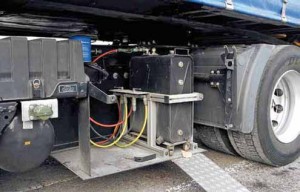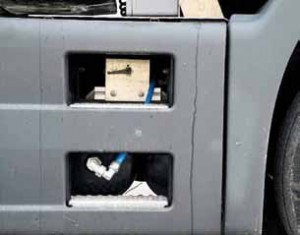Turbo lag eliminated on diesel engines, saving valuable energy
 For decades, engineers have been working tackling the problem of turbo lag on turbo-charged diesel engines – the performance lag which typically occurs when accelerating from rest or changing gear.
For decades, engineers have been working tackling the problem of turbo lag on turbo-charged diesel engines – the performance lag which typically occurs when accelerating from rest or changing gear.
The pneumatic booster system (PBS) developed by Knorr-Bremse helps improve throttle response and acceleration performance in trucks and buses. PBS will go into production in early 2013.
During acceleration, PBS briefly injects air from the vehicle’s compressed air system into the engine’s injection manifold. This allows a correspondingly larger amount of fuel to be injected, so that full-load torque is available almost immediately. A mechatronic product which has its own ECU and functionality software, PBS can interface directly with the engine management system.
 Initially, the development objective was simply to enhance performance and acceleration, where PBS can bring improvements of up to 150 per cent. As work continued however, customers became increasingly interested in the energy efficiency aspect.
Initially, the development objective was simply to enhance performance and acceleration, where PBS can bring improvements of up to 150 per cent. As work continued however, customers became increasingly interested in the energy efficiency aspect.
Here too, PBS opens up new possibilities, since in the context of efficiency the significant improvement in accelerating power can also be used to support downsizing or downspeeding.
Downsizing offers particularly promising potential for buses and delivery trucks – vehicles which are frequently fitted with larger engines than strictly necessary, in the interest of livelier performance. Using PBS it is possible to develop the same accelerating power from a 25-30 per cent smaller displacement. The customer sees the benefit in weight savings, which also leads to reduced fuel consumption and costs. Downspeeding has the advantage of reducing the engine speed even when driving at a constant road speed, thereby saving fuel.
Road-test report
After almost 20 years of commercial vehicle emission standards, Europe is now committed to introducing the first fuel economy standard. This could come into force as early as 2016, or at the latest by 2020. It is generally felt that cuts of between 14 and 20 per cent in fuel consumption may be required. But there is still have no clue as to what parameters will be measured, how they will be measured and against what baseline the reduction will be calculated.
 On fuel consumption, commercial vehicle manufacturers have currently reached an impasse. They know exactly where further improvements could be made, but when it comes to implementing them they are dependent on legislation – and above all on their suppliers.
On fuel consumption, commercial vehicle manufacturers have currently reached an impasse. They know exactly where further improvements could be made, but when it comes to implementing them they are dependent on legislation – and above all on their suppliers.
On the legislative front, they would like to see an increase of about half a metre in maximum vehicle length regulations. This would offer benefits both for aerodynamics and for fuel economy. However, it is doubtful whether such legislation will be forthcoming.
A much more realistic avenue would be to make use of supplier-developed technologies, such as PBS. A road test was performed to evaluate the claim of PBS that it significantly reduces fuel consumption on trucks and buses. The results of the test were quite astonishing.
 “PBS will be on the road by early 2013,” promises Knorr-Bremse test engineer Daniel Geis-Esser. Since Knorr-Bremse manufactures air brake systems, it is perhaps not surprising that PBS too is a compressed air-based system. This is hinted at by the “P” in the initials, which stands for “pneumatic”.
“PBS will be on the road by early 2013,” promises Knorr-Bremse test engineer Daniel Geis-Esser. Since Knorr-Bremse manufactures air brake systems, it is perhaps not surprising that PBS too is a compressed air-based system. This is hinted at by the “P” in the initials, which stands for “pneumatic”.
In a nutshell, the PBS system has the ambitious aim of eliminating turbo lag, by injecting compressed air into the engine’s intake manifold.
A large turbodiesel engine normally takes three or four seconds or even longer between the driver stepping on the accelerator and producing its maximum torque. With PBS, however, air from the compressed air tanks eliminates this performance lag and ensures faster throttle response. As a result, the acceleration shift points can be lowered, with a positive impact on fuel consumption. Depending on application, Knorr-Bremse says the system can achieve three to five per cent fuel savings.
 The design and operation of PBS are delightfully simple. The system consists of a cylindrical pipe with a centrally-located throttle valve, two pressure sensors, two diaphragm valves of different sizes and software whose job is to decide whether to inject compressed air and, if so, how much and for how long.
The design and operation of PBS are delightfully simple. The system consists of a cylindrical pipe with a centrally-located throttle valve, two pressure sensors, two diaphragm valves of different sizes and software whose job is to decide whether to inject compressed air and, if so, how much and for how long.
Whether compressed air injection is required will depend mainly on the driver’s throttle commands. The quantity of air supplied can range from 40 to 90 litres.
When PBS is activated, a number of things happen: the PBS throttle valve closes, air is injected into the manifold, and the engine rapidly builds up the necessary torque to match the throttle command and the rev needle flicks up by 100-200 rpm.
Simultaneously, the turbocharger comes up to speed much more quickly than it would without PBS, since the increase in torque is translated directly into a corresponding increase in exhaust gas energy.
The digital test instrument display shows a swift surge in turbocharger speed from 50,000 to 100,000 rpm. As soon as the pressure on either side of the throttle valve has equalised, the valve opens again and normal operation is resumed.
On the 27-kilometre test route, PBS on its own (without ECO mode) already brought a 1.9 per cent improvement in fuel consumption. The tests were carried out with an almost fully laden semi-trailer, drawn by a 316 kW (430 hp) MAN tractor unit with automated transmission. The test rig, sporting a complete array of test equipment, completed five laps of the relatively low-traffic test route, the first one being a familiarisation lap.
As the tests showed, the full potential of PBS only reveals itself when it is combined with a transmission controller with selectable Eco mode. Because PBS causes the engine to respond powerfully to all throttle commands, even at very low engine speeds, this can be exploited to lower the transmission’s shift points. When accelerating, the automated transmission will then shift up at, say, 1,300 rather than 1,500 rpm. When the engine speed drops back just below 1,000 rpm following the shift, PBS is activated and rpm climbs quickly and vigorously again.
The same principle applies when coasting in hilly terrain. A slight dip of the accelerator, resulting in PBS activation, may be sufficient to overcome the increased resistance when ascending a slight uphill grade. Without PBS, the transmission would shift down at this point. The positive effects of PBS noted in the test were an increased amount of driving time spent in top gear, a substantial rpm reduction and, finally, a hefty 6.9 per cent cut in fuel consumption on test lap 4. Test lap 3 had already recorded a 4.8 per cent saving but had to be repeated due to traffic disruption en route.
A 6.9 per cent saving, or fuel consumption of 31.06 litres/100 km instead of 33.35 litres, actually goes well beyond the manufacturer’s own claims. Similar measurements conducted earlier by Knorr-Bremse indicated a savings potential of the order of 4.3 per cent. Obviously, the actual savings achieved depend very much on the route being driven. Routes with relatively frequent starting from rest, frequent acceleration and hilly topography, like the test route used by last auto omnibus, result in higher savings. But even in long-haul operation, PBS should still be capable of achieving savings of two per cent, partly because a lower final-drive ratio can be used.
Clearly the biggest benefits of PBS will be in short-radius distribution and local public transport, where the system can be used to support engine downsizing, i.e., a smaller engine with PBS can replace a larger engine without this feature. PBS will probably make its debut in a bus.
So what are the downsides? Well, the system increases compressed air consumption by 20-30 per cent. This may require a larger air compressor and larger air tanks. On the test rig though, the standard-specification (360 cc) single-cylinder compressor proved to be sufficient, although supplementary tanks were fitted to increase air capacity by 80 litres. The big plus point is the short payback time of less than one year.